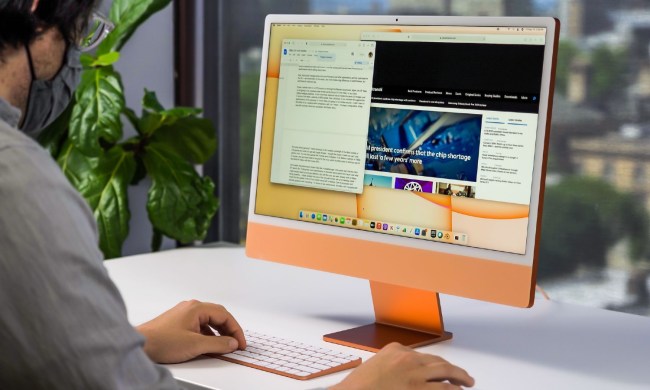The iMac doesn’t get a lot of attention at press keynotes or investor calls. In fact, Apple rarely gives it much attention at all. But for those looking for a clean all-in-one desktop setup, it’s a tried-and-true classic.
The best part? With its recent bump in specs and internal components, the iMac is now powerful enough to be a creative workhorse again. Between all the different options and configurations, though, it can be tough to know where to start. Here’s our guide to choosing the right iMac for you.
The new 4K and 5K options

In mid-March of 2019, Apple announced an update to the 21.5-inch
But performance is the real reason you should consider the 5K model. If you’re not overly familiar with how Intel processors work, the biggest gains can be found in the increased core counts. That’s why the jump from the quad-core Core i3 on the $1,300 model up to the $1,500 six-core model is worth the money. That’s also why the jump up to the eight-core option on the Core i9 is where the real power lies. Apple could have easily sold a 21.5-inch
The 5K model also gives you access to some higher-end graphics too. The range of AMD’s Radeon Pro graphics cards are spread throughout both models, including the Radeon Pro 570X, 575X, and 580X. Meanwhile, you can upgrade to the newer Radeon Pro Vega 48 only on the Core i9 5K model, while the Vega 20 is available on the
We haven’t tested these GPUs yet, but if you’re not needing to do any heavy lifting in terms of software or insane multitasking, the quad-core $1,299 model should do just fine for you. Regardless of which you choose, make sure you opt for the solid state drive. Apple still sells its Fusion Drive as the base storage across all configurations. You’ll need to pay to switch to a solid-state drive, but we highly recommend it.
You are able to upgrade your RAM on the 27-inch iMac via the removable back plate, but your storage is set in stone. Fortunately, you can always use an external hard drive or SSD later for extra capacity.
The sad, outdated base model

We also need to talk about the iMac you should probably avoid. The 21.5-inch 1080p model.
There’s nothing inherently wrong with such a device — in fact, the $1,099 starting price alone is enough to catch your attention. However, this model has missed the boat on a couple of opportunities to be updated. What’s so bad about it? Well, for starters, it has an older-generation Core i5 processor. It’s only a dual-core processor, which means you’ll be a bit limited in terms of multitasking compared to the quad-core or six-core processors in newer generations.
On the graphics side of things, you’re also a bit limited. With only Intel Iris Graphics 640 at your disposal, you’ll have much less help with tasks like video rendering or gaming. You’ll find better performance in a modern laptop at around the same price.
If you do end up getting the base model, at the very least do yourself a favor and upgrade to the 256GB solid-state drive. The lowest configuration includes only a 1TB 5400 RPM hard drive for storage, and that will be a major bottleneck on your daily performance. The solid-state drive has less capacity, but it’s make a significant difference in how quick the system feels. Because it got left out of the 2019 processor update, we have little hope Apple will update the specs of this machine anytime soon.
What about the iMac Pro?

Last, but certainly not least, is the iMac Pro. It’s the cream of the crop — the most powerful computer Apple has ever made. It’s also the most expensive, with a starting price of $5,000. Yup, you read that right.
What you get, however, is some unbridled workstation power. The Intel Xeon W processors start at 10 cores and max out at 18. Meanwhile, AMD’s Vega graphics range up to the Vega 64X. That’s not the most powerful graphics card you can buy, but it’s pretty killer addition as a content creation or gaming component. It also comes in a flashy space gray that sets it apart from the rest of the iMac lineup.
With the recent update to the iMac, though, the Pro is for people with a need for huge amounts of power. You’ll no doubt notice a different between the capabilities of the top-of-the-line 5K iMac and the iMac Pro, but there’s no longer as big of a gap. If you’re waiting for something with a bit more flexibility, a new modular Mac Pro is set to be launched in 2019, alongside an external 6K display.


